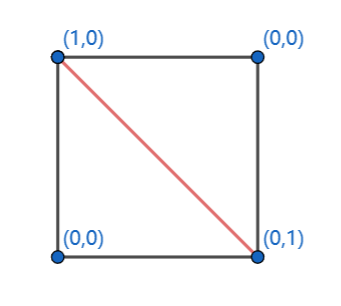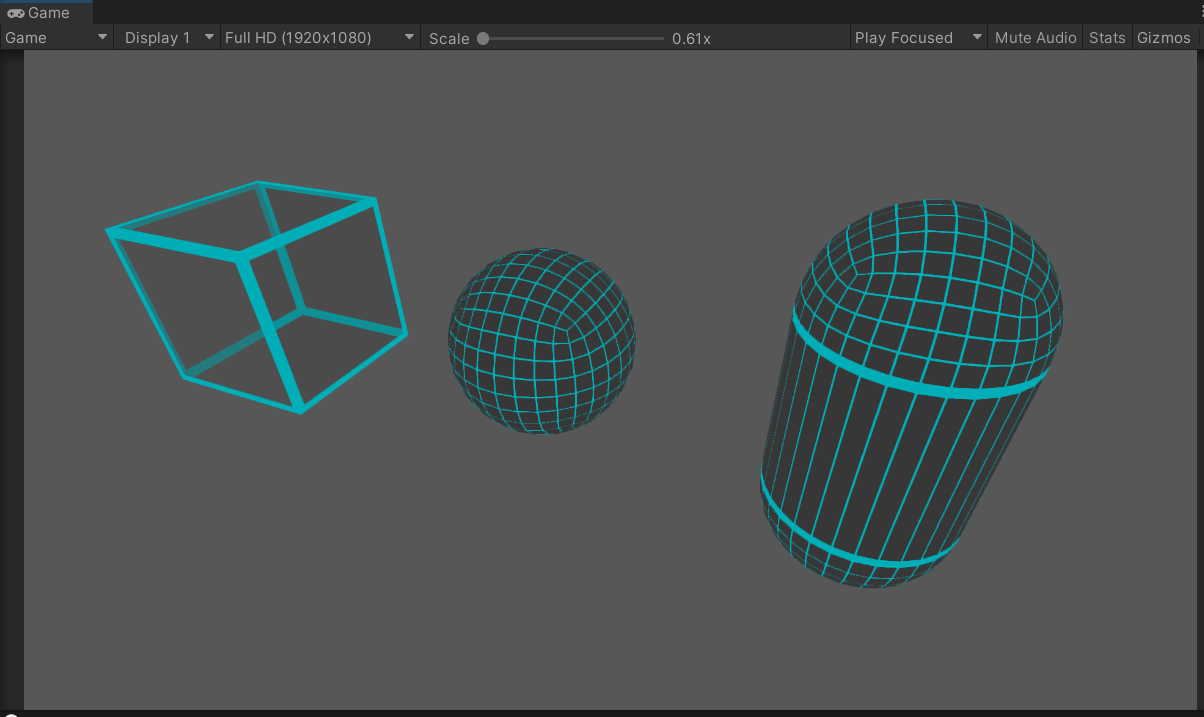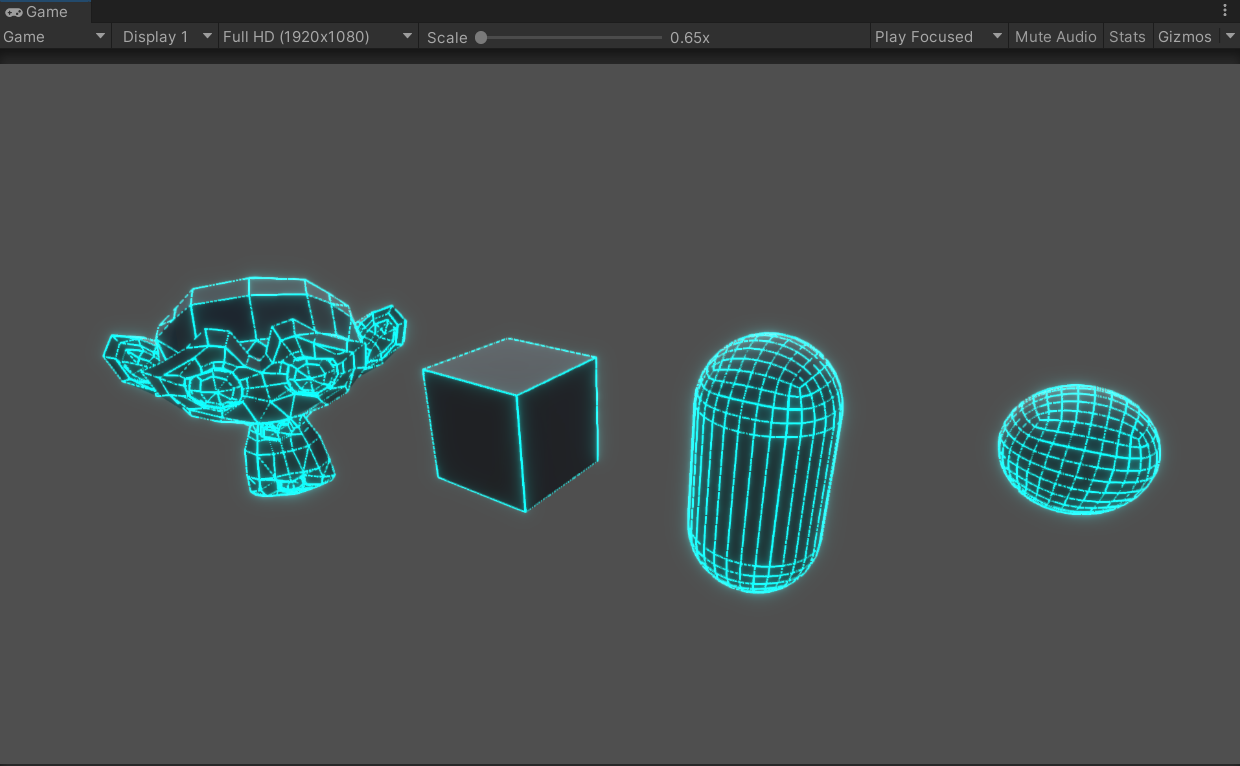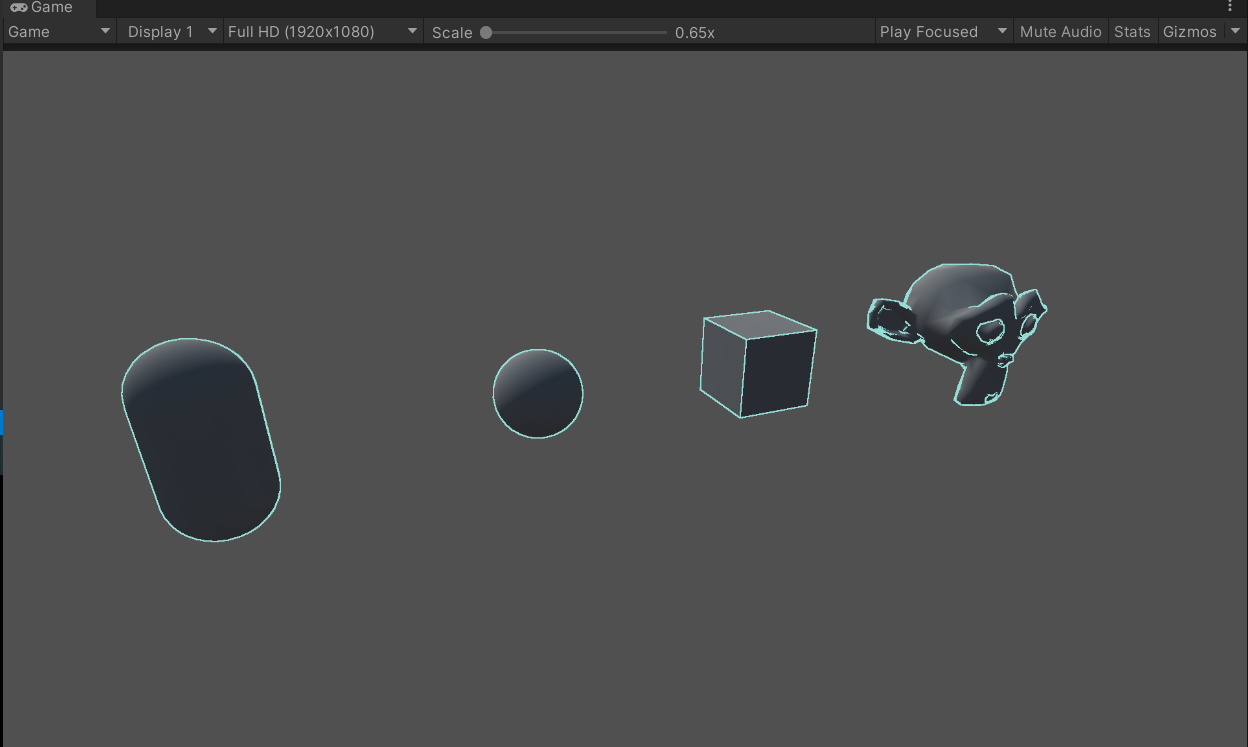【unity】网格描边方法
介绍对模型四边网格的三种描边方法:包括纯Shader方法、创建网格方法和后处理方法。于增强场景中3D模型的轮廓,使其在视觉上更加突出和清晰。这种效果可以用于增强三维场景中的物体、角色或环境,使其在视觉上更加吸引人。
Shader方法
使用GeometryShader方法对三角网进行计算,目的是保留距离最短的两条边。在进行计算时,首先需要建立一个float2 dist来储存点的信息。在进行插值后,需要保留边的dist,其中一个数值为0,以此为依据来绘制边。下图展示了顶点dist的赋值情况。
这种方法可以让我们在渲染三角网时,根据点之间的距离信息来动态地调整边的绘制,从而实现更加真实和精细的渲染效果。

实现效果

实现shader
Shader "Unlit/WireframeMesh"
{
Properties
{
_MainTex("Texture", 2D) = "white" {
}
_WireColor("WireColor", Color) = (1, 0, 0, 1)
_FillColor("FillColor", Color) = (1, 1, 1, 1)
_WireWidth("WireWidth", Range(0, 1)) = 1
}
SubShader
{
Tags {
"RenderType" = "Transparent" "Queue" = "Transparent" }
LOD 100
AlphaToMask On // 为此通道启用减法混合
Pass
{
Blend SrcAlpha OneMinusSrcAlpha
Cull Off
CGPROGRAM
#pragma vertex vert
#pragma geometry geom //添加几何阶段
#pragma fragment frag
#include "UnityCG.cginc"
struct appdata
{
float4 vertex: POSITION;
float2 uv: TEXCOORD0;
};
struct v2g
{
float2 uv: TEXCOORD0;
float4 vertex: SV_POSITION;
};
struct g2f
{
float2 uv: TEXCOORD0;
float4 vertex: SV_POSITION;
float2 dist: TEXCOORD1;
float maxlenght : TEXCOORD2;
};
sampler2D _MainTex;
float4 _MainTex_ST;
float4 _FillColor, _WireColor;
float _WireWidth, _Clip, _Lerp, _WireLerpWidth;
//视口到几何
v2g vert(appdata v)
{
v2g o;
o.vertex = v.vertex;
o.uv = TRANSFORM_TEX(v.uv, _MainTex);
return o;
}
//几何到片元
[maxvertexcount(3)]
void geom(triangle v2g IN[3], inout TriangleStream < g2f > triStream)
{
//读取三角网各个顶点
float3 p0 = IN[0].vertex;
float3 p1 = IN[1].vertex;
float3 p2 = IN[2].vertex;
//计算三角网每一边的长度
float v0 = length(p1 - p2);
float v1 = length( p2 - p0);
float v2 = length( p0 - p1);
//求出最长边
float v_max = max(v2,max(v0, v1));
//每一边减最长边,小于0时为0,等于0时为1
float f0 = step(0, v0 - v_max);
float f1 = step(0, v1 - v_max);
float f2 = step(0, v2 - v_max);
//赋值传到片元操作
g2f OUT;
OUT.vertex = UnityObjectToClipPos(IN[0].vertex);
OUT.uv = IN[0].uv;
OUT.maxlenght = v_max;
OUT.dist = float2(f1, f2);
triStream.Append(OUT);
OUT.vertex = UnityObjectToClipPos( IN[1].vertex);
OUT.uv = IN[1].uv;
OUT.maxlenght = v_max;
OUT.dist = float2(f2, f0);
triStream.Append(OUT);
OUT.vertex = UnityObjectToClipPos( IN[2].vertex);
OUT.maxlenght = v_max;
OUT.uv = IN[2].uv;
OUT.dist = float2(f0, f1);
triStream.Append(OUT);
}
//片元阶段
fixed4 frag(g2f i) : SV_Target
{
fixed4 col = tex2D(_MainTex, i.uv );
fixed4 col_Wire= col* _FillColor;
//取dist最小值
float d = min(i.dist.x, i.dist.y);
//d小于线宽是赋值线颜色,否则赋值背景颜色
col_Wire = d < _WireWidth ? _WireColor : col_Wire;
fixed4 col_Tex = tex2D(_MainTex, i.uv);
return col_Wire;
}
ENDCG
}
}
}
该方法不支持webGL,原因webGL不支持GeometryShader。
介绍一个根据uv创建网格的方法,虽然支持webGL,但是局限性太大,不做详细介绍,附上shader
Shader "Unlit/WireframeUV"
{
Properties
{
_MainTex ("Texture", 2D) = "white" {
}
_FillColor("FillColor", Color) = (1, 1, 1, 1)
[HDR] _WireColor("WireColor", Color) = (1, 0, 0, 1)
_WireWidth("WireWidth", Range(0, 1)) = 1
}
SubShader
{
Tags {
"RenderType"="Opaque" }
LOD 100
AlphaToMask On
Pass
{
Tags {
"RenderType" = "TransparentCutout" }
Blend SrcAlpha OneMinusSrcAlpha
Cull Off
CGPROGRAM
#pragma vertex vert
#pragma fragment frag
#include "UnityCG.cginc"
struct appdata
{
float4 vertex : POSITION;
float2 uv : TEXCOORD0;
};
struct v2f
{
float2 uv : TEXCOORD0;
float4 vertex : SV_POSITION;
};
sampler2D _MainTex;
float4 _MainTex_ST;
fixed4 _FillColor;
fixed4 _WireColor;
float _WireWidth;
v2f vert (appdata v)
{
v2f o;
o.vertex = UnityObjectToClipPos(v.vertex);
o.uv = TRANSFORM_TEX(v.uv, _MainTex);
return o;
}
fixed4 frag (v2f i) : SV_Target
{
fixed4 col = tex2D(_MainTex, i.uv);
fixed2 uv2 = abs(i.uv - fixed2(0.5f, 0.5f));
float minUV = max(uv2.x, uv2.y);
col = minUV < 0.5- _WireWidth ? col* _FillColor : _WireColor;
return col;
}
ENDCG
}
}
}
创建网格方法
这个方法支持在内置built-in管线中使用,实现原理和shader方法类似,不同的是需要构建线网格。根据原有三角网格抽取其中最短两条重新绘制。
实现效果

因为CommandBuffer方法暂时无法设置线宽,用了一些后处理方法
实现的方法
using System.Collections.Generic;
using UnityEngine;
using UnityEngine.Rendering;
public class CamerDrawMeshDemo : MonoBehaviour
{
[SerializeField]
MeshFilter meshFilter;
CommandBuffer cmdBuffer;
[SerializeField]
Material cmdMat1;
// Start is called before the first frame update
void Start()
{
//创建一个CommandBuffer
cmdBuffer = new CommandBuffer() { name = "CameraCmdBuffer" };
Camera.main.AddCommandBuffer(CameraEvent.AfterForwardOpaque, cmdBuffer);
DarwMesh();
}
//绘制网格
void DarwMesh()
{
cmdBuffer.Clear();
Mesh m_grid0Mesh = meshFilter.mesh;//读取原有网格,这里需要开启网格可读写
cmdBuffer.DrawMesh(CreateGridMesh(m_grid0Mesh), Matrix4x4.identity, cmdMat1);
}
//创建网格
Mesh CreateGridMesh(Mesh TargetMesh)
{
Vector3[] vectors= getNewVec(TargetMesh.vertices);
//模型坐标转换到世界坐标
Vector3[] getNewVec(Vector3[] curVec)
{
int count = curVec.Length;
Vector3[] vec = new Vector3[count];
for (int i = 0; i < count; i++)
{
//坐标转型,乘上变化矩阵
vec[i] =(Vector3)(transform.localToWorldMatrix* curVec[i])+transform.position;
}
return vec;
}
int[] triangles = TargetMesh.triangles;
List<int> indicesList = new List<int>(2);
//筛选绘制边
for (int i = 0; i < triangles.Length; i+=3)
{
Vector3 vec;
int a = triangles[i];
int b = triangles[i+1];
int c = triangles[i+2];
vec.x = Vector3.Distance(vectors[a], vectors[b]);
vec.y = Vector3.Distance(vectors[b], vectors[c]);
vec.z = Vector3.Distance(vectors[c], vectors[a]);
addList(vec, a,b,c);
}
void addList(Vector3 vec,int a,int b,int c)
{
if (vec.x< vec.y|| vec.x <vec.z)
{
indicesList.Add(a);
indicesList.Add(b);
}
if (vec.y < vec.x || vec.y < vec.z)
{
indicesList.Add(b);
indicesList.Add(c);
}
if (vec.z < vec.x || vec.z < vec.y)
{
indicesList.Add(c);
indicesList.Add(a);
}
}
int[] indices = indicesList.ToArray();
//创建网格
Mesh mesh = new Mesh();
mesh.name = "Grid ";
mesh.vertices = vectors;
mesh.SetIndices(indices, MeshTopology.Lines, 0);
return mesh;
}
}
后处理方法
利用深度纹理和法线纹理来比较相邻像素之间的相似性,以判断它们是否位于物体的边缘,并进而实现描边效果。具体而言,该算法会对相邻像素的深度值和法线值进行比较,若它们之间的差异超过一定阈值,则认为这两个像素位于物体的边缘上。通过这一方法,我们可以在渲染时对边缘进行特殊处理,以实现描边效果。
实现效果

实现方法
建立后渲染脚本挂载在主相机上
using System.Collections;
using System.Collections.Generic;
using UnityEngine;
public class SceneOnlineDemo : MonoBehaviour
{
public Shader OnlineShader;
Material material;
[ColorUsage(true, true)]
public Color ColorLine;
public Vector2 vector;
public float LineWide;
// Start is called before the first frame update
void Start()
{
material = new Material(OnlineShader);
GetComponent<Camera>().depthTextureMode |= DepthTextureMode.DepthNormals;
}
void Update()
{
}
void OnRenderImage(RenderTexture src, RenderTexture dest)
{
if (material != null)
{
material.SetVector("_ColorLine", ColorLine);
material.SetVector("_Sensitivity", vector);
material.SetFloat("_SampleDistance", LineWide);
Graphics.Blit(src, dest, material);
}
else
{
Graphics.Blit(src, dest);
}
}
}
后处理shader挂载在SceneOnlineDemo 脚本上
Shader "Unlit/SceneOnlineShader"
{
Properties
{
_MainTex ("Texture", 2D) = "white" {}
[HDR] _ColorLine("ColorLine", Color) = (1,1,1,1) //颜色,一般用fixed4
_Sensitivity("Sensitivity", Vector) = (1, 1, 1, 1) //xy分量分别对应法线和深度的检测灵敏度,zw分量没有实际用途
_SampleDistance("Sample Distance", Float) = 1.0
}
SubShader
{
Tags { "RenderType" = "Opaque" }
LOD 100
Pass
{
ZTest Always Cull Off ZWrite Off
CGPROGRAM
#pragma vertex vert
#pragma fragment frag
#include "UnityCG.cginc"
sampler2D _MainTex;
half4 _MainTex_TexelSize;
sampler2D _CameraDepthNormalsTexture; //深度+法线纹理
sampler2D _CameraDepthTexture;
fixed4 _ColorLine;
float _SampleDistance;
half4 _Sensitivity;
struct v2f
{
half2 uv[5]: TEXCOORD0;
float4 vertex : SV_POSITION;
};
v2f vert (appdata_img v)
{
v2f o;
o.vertex = UnityObjectToClipPos(v.vertex);
half2 uv = v.texcoord;
o.uv[0] = uv;
#if UNITY_UV_STARTS_AT_TOP
if (_MainTex_TexelSize.y < 0)
uv.y = 1 - uv.y;
#endif
//建立相邻向量数组
o.uv[1] = uv + _MainTex_TexelSize.xy * half2(1, 1) * _SampleDistance;
o.uv[2] = uv + _MainTex_TexelSize.xy * half2(-1, -1) * _SampleDistance;
o.uv[3] = uv + _MainTex_TexelSize.xy * half2(-1, 1) * _SampleDistance;
o.uv[4] = uv + _MainTex_TexelSize.xy * half2(1, -1) * _SampleDistance;
return o;
}
//检查是否相似
half CheckSame(half4 center, half4 sample) {
half2 centerNormal = center.xy;
float centerDepth = DecodeFloatRG(center.zw);
half2 sampleNormal = sample.xy;
float sampleDepth = DecodeFloatRG(sample.zw);
// 法线相差
half2 diffNormal = abs(centerNormal - sampleNormal) * _Sensitivity.x;
int isSameNormal = (diffNormal.x + diffNormal.y) < 0.1;
// 深度相差
float diffDepth = abs(centerDepth - sampleDepth) * _Sensitivity.y;
// 按距离缩放所需的阈值
int isSameDepth = diffDepth < 0.1 * centerDepth;
// return:
// 1 - 如果法线和深度足够相似
// 0 - 相反
return isSameNormal * isSameDepth ? 1.0 : 0.0;
}
fixed4 frag (v2f i) : SV_Target
{
fixed4 col = tex2D(_MainTex, i.uv[0]);
half4 sample1 = tex2D(_CameraDepthNormalsTexture, i.uv[1]);
half4 sample2 = tex2D(_CameraDepthNormalsTexture, i.uv[2]);
half4 sample3 = tex2D(_CameraDepthNormalsTexture, i.uv[3]);
half4 sample4 = tex2D(_CameraDepthNormalsTexture, i.uv[4]);
half edge = 1.0;
edge *= CheckSame(sample1, sample2);
edge *= CheckSame(sample3, sample4);
fixed4 withEdgeColor = lerp(_ColorLine, col, edge);
return withEdgeColor;
}
ENDCG
}
}
}